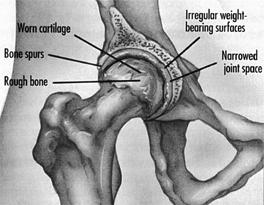Hip Arthritis
Osteoarthritis is the “wear and tear” form of arthritis that most patients have. It is often explained to patients as being a gradual wear of the joint (“it's not the years, it's the mileage”), although it typically does not become clinically significant until middle age or later. Nearly all adults over the age of 40 will demonstrate at least some osteoarthritis in their joints even though it may not cause pain or problems for many years.
The cartilage coating over the joints wears away, eventually exposing the underlying bony surfaces (like scraping away the Teflon in the frying pan). As this occurs, the body reacts by forming large bone spurs (called osteophytes), extra joint fluid (which may cause joint fluid accumulation), hard underlying bone surfaces (subchondral sclerosis), or cysts around the joint.
Eventually, the hip joint begins to resemble a cauliflower more than a smooth, round ball. This usually causes pain in the groin, although it may radiate to the knee, buttock, or side of the hip. As osteoarthritis progresses, the joint becomes progressively stiff, so that it becomes difficult to put on shoes and socks, clip toenails, get up out of a chair, etc.
Related forms of osteoarthritis include posttraumatic arthritis (arthritis that forms after an old injury – usually a fracture or dislocated hip), late consequences of prior diseases (patients who had slipped capital epiphyses or Legg-Calve-Perthes disease as children), and congenital defects such as a shallow hip socket (hip dysplasia).
If you have osteoarthritis of the hip that is preventing you from living the life you want, contact Orthopaedics New England for a consultation with one of our hip replacement surgeons in Middlebury, New Milford, and Farmington, Connecticut. They will recommend the optimal treatment for you and guide you in your decision-making process. Call (203) 598-0700 today or you can request an appointment online.





